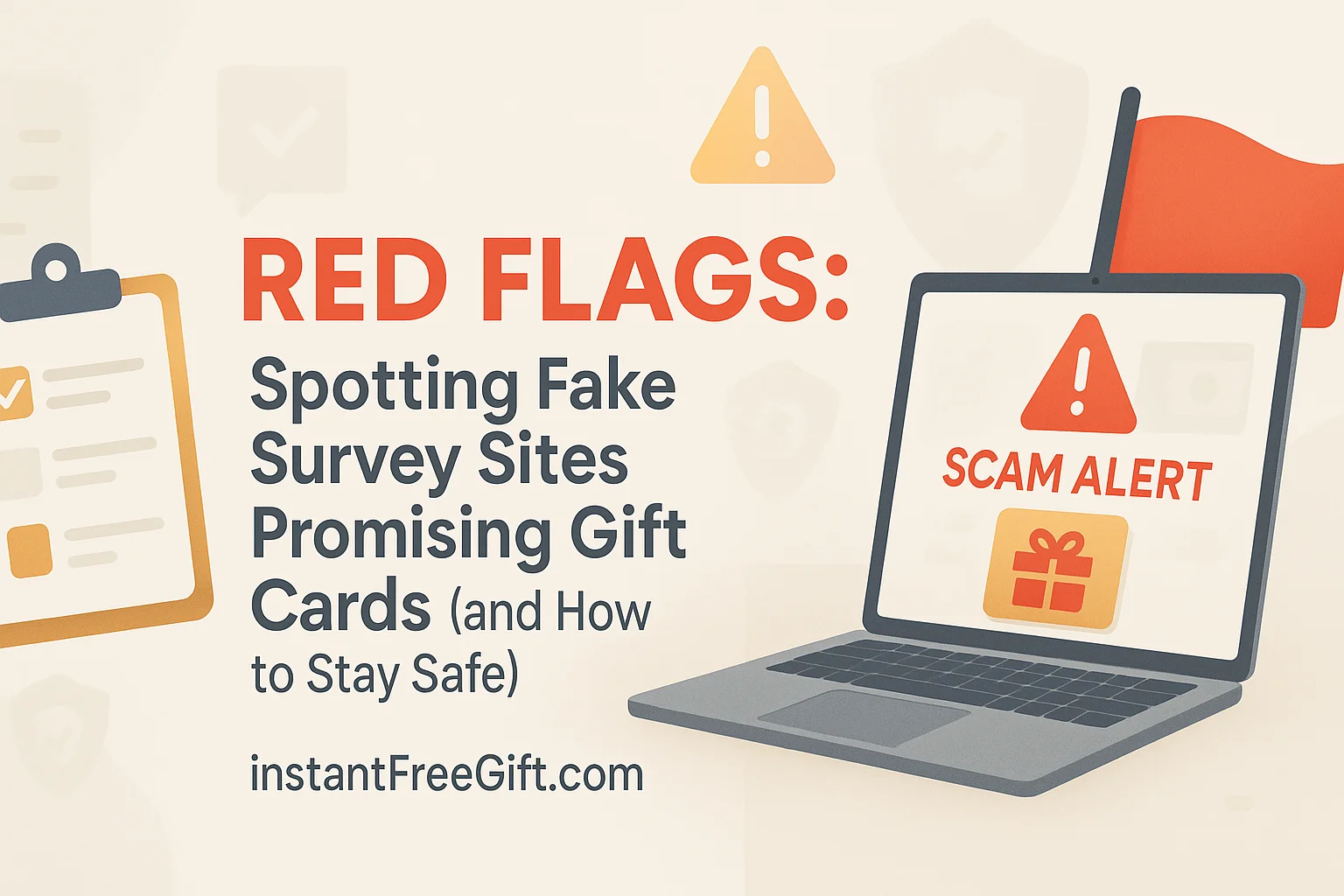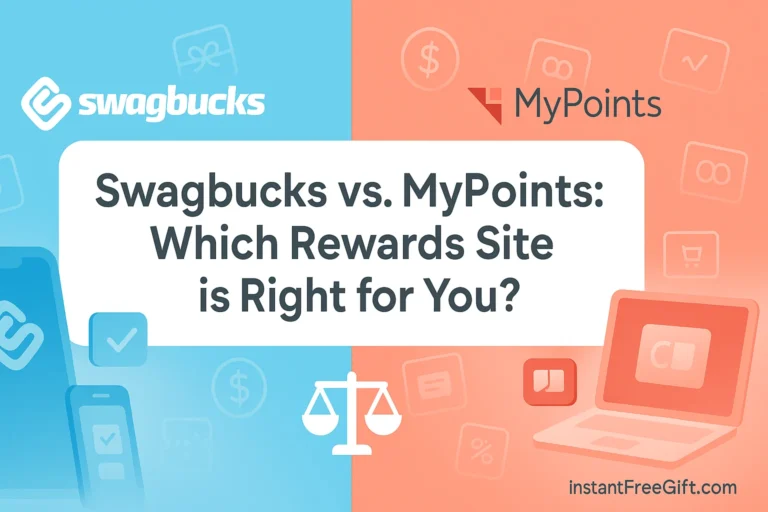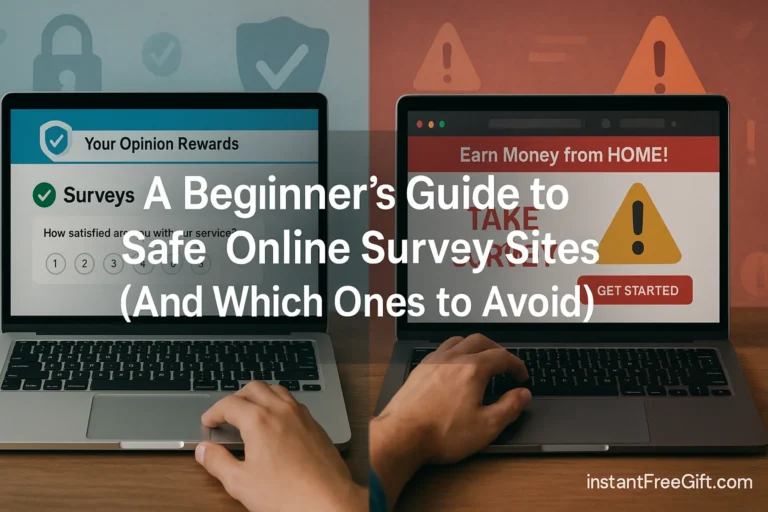Red Flags: Spotting Fake Survey Sites Promising Gift Cards

Sarah was excited when she received an email promising $50 Amazon gift cards for completing a “quick 5-minute survey.” As a college student with mounting textbook expenses, the offer seemed like a blessing. She clicked through, answered dozens of increasingly personal questions, and after 30 minutes—far longer than promised—was asked to “verify her identity” by providing her Social Security number and bank details to receive payment.
Fortunately, Sarah hesitated and decided to research the company first. What she discovered was alarming: the supposedly “reputable market research firm” didn’t exist outside of a hastily created website registered just three days earlier.
Every day, thousands of people fall victim to fake survey sites promising easy money and valuable gift cards. These scams don’t just waste your time—they can lead to identity theft, financial fraud, and malware infections that compromise your digital security. According to the Federal Trade Commission, Americans lost over $8.8 billion to fraud in 2022, with a significant portion coming from online scams including fake surveys.
In this comprehensive guide, we’ll walk you through exactly how to identify and avoid survey scams. You’ll learn the telltale survey scam red flags that signal danger, practical steps to verify legitimacy, and what actions to take if you suspect you’ve encountered a scam. Our goal isn’t to discourage you from taking surveys—legitimate platforms do exist—but to empower you with the knowledge to protect yourself while safely participating in genuine opportunities.
Why Fake Survey Sites Exist
Motivation: The Profitable Business of Deception
Creating fake survey sites is surprisingly lucrative for scammers, which explains their persistent presence online. Their primary motivations include:
- Data Harvesting: Personal information is incredibly valuable on the dark web. Names, emails, addresses, and especially financial details can be sold to third parties or used directly for identity theft.
- Malware Distribution: Some survey sites are designed to install malicious software on your device that can track your keystrokes, access your webcam, or encrypt your files for ransom.
- Ad Revenue Generation: Even if a site doesn’t steal your information directly, forcing you through endless pages of ads generates significant revenue for scammers.
- Affiliate Marketing Abuse: Many fake surveys redirect users through affiliate links, earning the scammers commissions for products you may purchase later.
Target Audience: Who’s Most Vulnerable?
While anyone can fall victim to these scams, fake survey sites particularly target:
- Beginners new to online earning: People unfamiliar with legitimate survey rates and practices are less likely to recognize unrealistic promises.
- Those facing financial hardship: When you need money urgently, the promise of quick cash can override caution.
- Tech-unsavvy individuals: People with limited technical knowledge may struggle to identify security red flags.
- Young adults and students: Often seeking side income with flexible schedules, this demographic is frequently targeted.
Understanding these motivations helps us better recognize and spot fake survey sites before they can do harm. Now, let’s explore the specific warning signs to watch for.
The Top Red Flags to Watch For

1. Unrealistic Payout Promises
One of the clearest signs of a scam is compensation that sounds too good to be true. Legitimate market research values your time and opinions, but there are standard industry rates.
Red Flag Example: “Make $100 per survey!” or “Earn $1,000 weekly taking surveys in your spare time!”
Reality Check: Genuine survey sites typically pay between $0.50 and $5 per survey, with occasional higher-paying studies for specialized demographics or longer formats. Most dedicated survey takers earn between $50-$300 monthly, not thousands.
When you encounter a site promising extraordinary returns for minimal effort, it’s almost certainly a gift card scam designed to lure unsuspecting victims.
2. Requests for Sensitive Personal Information Upfront
Legitimate survey sites need basic demographic information to match you with appropriate surveys, but there’s certain information they should never request—especially before you’ve established any relationship with them.
Red Flag Example: Registration forms asking for your Social Security Number, credit card details, bank account information, or copies of identification documents.
Why It’s Dangerous: This information enables direct identity theft and financial fraud. No legitimate survey company needs your SSN or banking details to register you—payment processors like PayPal only require your email address.
Remember: your personal data is valuable—be as protective of it online as you would be with your physical wallet.
3. Lack of Contact Information or Transparency
Companies conducting genuine market research want to establish credibility and maintain professional relationships with their panel members.
Red Flag Example: Websites with no “About Us” page, missing contact information, lack of physical business address, or absence of a customer service email/phone number.
Why It Matters: Legitimate businesses openly share their identity, location, and multiple contact methods. They want to be accountable and accessible to their users. When a site obscures this basic information, they’re likely trying to avoid accountability for fraudulent activities.
Try contacting the company through provided channels before investing significant time in their platform. If your messages bounce back or you receive no response within a reasonable timeframe, consider it a warning sign.
4. Poor Website Design and Grammar
Professional market research companies invest in their online presence because it reflects their business standards and helps attract legitimate clients and participants.
Red Flag Example: Sites with mismatched fonts, broken images, non-functioning links, obvious template elements, and content filled with grammatical errors or awkward phrasing.
Why It Matters: While not all legitimate sites have perfect design, and not all scam sites look terrible, there’s often a correlation between site quality and legitimacy. Major errors suggest either a hastily created scam or a company that doesn’t invest in quality—neither inspires confidence in their payment reliability.
Pay special attention to inconsistencies in branding or design elements that seem copied from better-known sites, which often indicates impersonation attempts.
5. Negative User Reviews and Complaints
Other users’ experiences can provide valuable insights into a survey site’s legitimacy and practices.
Red Flag Example: Multiple reports of non-payment, account closures just before payout thresholds, suddenly “disqualifying” users from surveys after they’ve spent substantial time on them, or selling user data despite privacy promises.
Where to Look: Check Trustpilot, Better Business Bureau, Reddit forums like r/beermoney, and simply searching “[Site Name] + scam” or “[Site Name] + review” on Google.
Interpreting Reviews: Look for patterns rather than isolated complaints. Even legitimate sites occasionally have technical issues or individual misunderstandings. However, consistent complaints about the same problems, especially payment-related ones, should be taken seriously.
6. Suspicious Payment Methods or “Fees”
The payment structure and methods can reveal much about a survey site’s legitimacy.
Red Flag Example: Requirements to pay a “registration fee,” “account activation charge,” or purchase a “membership” before accessing surveys or receiving payments.
Another Red Flag: Only offering obscure payment methods, cryptocurrency, or wire transfers rather than standard options like PayPal, direct deposit, or major gift cards.
Why It’s Suspicious: Legitimate survey sites pay YOU—they don’t charge you. Any site requiring upfront payment is almost certainly a scam. Similarly, unusual payment methods are often chosen because they offer less fraud protection and are harder to trace or reverse.
7. Pressure to Refer Friends Before Earning
While many legitimate sites have referral programs as an additional earning option, suspicious sites make them mandatory for payment.
Red Flag Example: “You must refer 10 friends before withdrawing your earnings” or “Unlock payment by sharing this survey on social media.”
Why It’s Problematic: This tactic serves two purposes for scammers: it delays having to pay you (often indefinitely) while simultaneously recruiting more victims through your trusted connections. Legitimate sites may offer bonuses for referrals but never make them mandatory for accessing your earned rewards.
8. Complex and Confusing Terms of Service (or Lack Thereof)
Terms of Service documents should clearly explain how the site works, your rights, and their obligations.
Red Flag Example: Missing Terms of Service entirely, terms written in extremely technical language, or clauses that seem unreasonably restrictive (such as “We reserve the right to terminate accounts for any reason without notice”).
What to Look For: Check for clear explanation of payment thresholds, payout schedules, disqualification policies, and data usage permissions. If these elements are missing or excessively vague, the site may be avoiding legal accountability.
Pay particular attention to any clauses allowing them to change terms without notice or those requiring binding arbitration, which can limit your recourse if problems arise.
9. Constant Redirects and Pop-Up Ads
User experience reveals a lot about a site’s priorities and business model.
Red Flag Example: Sites that bombard you with pop-ups, repeatedly redirect you to other websites, or force you to click through multiple advertisement pages before accessing actual survey content.
Why It’s Concerning: Excessive advertising suggests the site’s primary revenue comes from ad impressions rather than legitimate market research. While some ads are normal on free sites, an overwhelming amount indicates the “surveys” may just be bait to expose you to advertising.
More concerningly, these redirects can lead to malware-infected sites or phishing attempts designed to steal your information.
10. Newly Registered Domain
The age of a website can provide clues about its legitimacy and stability.
Red Flag Example: A site claiming to be “established in 2010” but whose domain was registered last month.
How to Check: Use tools like WHOIS Lookup or Domain Age Checker to verify when the domain was first registered.
Why It Matters: While legitimate new businesses do launch regularly, scam sites tend to have very short lifespans—often disappearing after a few months when complaints mount or they’ve collected enough data. Be especially cautious with new domains making grand claims about their history or success.
11. No Security Certificates
Data security should be a priority for any site collecting personal information.
Red Flag Example: URLs beginning with “http://” rather than “https://” or browsers displaying “Not Secure” warnings when visiting the site.
Why It Matters: The “s” in “https” stands for “secure”—it indicates that the connection between your browser and the website is encrypted, protecting your data from interception. Legitimate businesses invest in these security certificates to protect both themselves and their users. A site without basic security measures is either negligent or deliberately avoiding security investments because they don’t plan to operate legitimately long-term.
Look for the padlock icon in your browser’s address bar, which indicates a secure connection.
12. Lack of Privacy Policy
Privacy policies are legally required for websites collecting personal data in most jurisdictions.
Red Flag Example: No privacy policy link anywhere on the site, or a policy that’s vague about how your data will be used and shared.
What to Look For: Clear statements about what data is collected, how it’s used, whether it’s shared with third parties, and how you can request its deletion if desired.
Why It Matters: Legitimate survey companies are transparent about data usage because market research depends on ethical data handling. A missing or inadequate privacy policy suggests either ignorance of legal requirements (concerning) or deliberate evasion of them (alarming).
How to Verify the Legitimacy of a Survey Site
Check User Reviews and Ratings
Before investing time in any survey platform, research what others have experienced with it.
Recommended Resources:
- Trustpilot for general business reviews
- Better Business Bureau for records of complaints and their resolution
- Reddit communities like r/beermoney and r/SurveyExchange
- Survey-specific review sites like Survey Police
Critical Review Reading Tips:
- Look for specific, detailed experiences rather than vague praise or complaints
- Be wary of reviews that sound too similar or were posted in large batches on the same date
- Check if the company responds to negative reviews and how they handle criticism
- Consider the overall pattern rather than isolated incidents
Remember that even legitimate survey sites occasionally have technical glitches or user misunderstandings. What matters is how consistently problems occur and how the company addresses them.
Look for Contact Information and Test It
A legitimate business should be reachable through multiple channels.
Action Steps:
- Look for a dedicated “Contact” or “Customer Support” page
- Verify they provide at least an email address and ideally a phone number
- Send a test email with a simple question about their services
- Check for a physical business address and verify it exists using Google Maps
Red Flag Response Patterns:
- No response after 2-3 business days
- Bounced emails
- Automated responses with no follow-up
- Evasive answers that don’t address your specific questions
The quality and promptness of customer service often reflects a company’s overall legitimacy and professionalism.
Review the Terms of Service
While most people skip reading Terms of Service, with potential scams it’s worth investing the time.
Key Elements to Check:
- Payment Terms: Clear explanation of how much you’ll earn, minimum payout thresholds, and payment timeframes
- Account Termination Policies: Reasonable grounds for account closure or reward forfeiture
- Dispute Resolution: Processes for addressing payment issues or technical problems
- Data Usage Rights: Specific information about how your survey responses will be used
- Change Notification: How and when they’ll inform you of changes to terms or rates
Red Flags in Terms:
- Extremely high payout thresholds (e.g., $50+ for a new site)
- Vague language allowing them to withhold payment for unspecified “suspicious activity”
- Terms that allow them to change conditions without notice
- No mention of data protection or confidentiality
If terms seem deliberately confusing or heavily skewed against users, proceed with caution.
Research the Company
Background research can reveal whether a survey site has a legitimate business presence.
Investigation Steps:
- Search for the company name + “reviews,” “scam,” or “legitimate”
- Look for a LinkedIn company page and check employee profiles
- Search business registration databases in their stated location
- Check if they’re members of market research associations like ESOMAR or the Market Research Society
- Verify how long they’ve been operating based on online presence and references
Positive Indicators:
- Consistent company information across platforms
- Real employees with verifiable work histories
- Membership in professional organizations
- Media mentions or partnerships with known brands
A legitimate market research company typically has an established industry presence beyond just their survey website.
Use Website Checker Tools
Technical verification tools can reveal hidden information about websites.
Recommended Tools:
- ScamAdviser for overall risk assessment
- WHOIS Lookup for domain registration details
- VirusTotal to check for malicious code
- SSL Checker to verify security certificates
What to Look For:
- Domain age consistency with claimed company history
- Registration information matching claimed business location
- Proper security implementation
- No malware or phishing alerts
These technical checks can reveal discrepancies that might not be obvious from the website’s appearance alone.
Reverse Image Search
Many scam sites use stock photos or stolen images to appear legitimate.
How to Do It:
- Right-click on profile photos of supposed “team members” or testimonial images
- Select “Search image with Google” (or use TinEye)
- Check if the same images appear across multiple unrelated websites
Why It Works: Legitimate businesses use real photos of their team and customers, while scammers often rely on generic stock images or stolen photos. Finding the same “CEO” photo across multiple unrelated businesses is a strong indication of fraud.
Check Social Media Profiles
A company’s social media presence can provide insights into its legitimacy and operations.
What to Examine:
- Consistent branding across platforms
- Regular posting history (not just recent activity)
- Engagement with followers and responses to comments
- Realistic follower counts relative to claimed company size
- User tags and mentions from real people
Red Flags:
- Recently created accounts with limited history
- No engagement despite high follower counts (potentially purchased followers)
- No responses to user complaints
- Inconsistent company information across platforms
Legitimate survey companies typically maintain active social media presences to recruit new panel members and share research insights.
What To Do If You Suspect a Survey Site is Fake
Trust Your Gut
Your intuition is often your first line of defense against scams.
If something feels wrong—unusual questions, too-good-to-be-true rewards, or unprofessional interactions—it’s worth pausing to reassess. Many scam victims report having initial doubts they unfortunately ignored.
Don’t let the prospect of easy money override your natural caution. Legitimate opportunities will still be there after you’ve done your due diligence.
Stop Using the Site Immediately
If you determine a site is likely fraudulent, cease all activity right away.
Action Steps:
- Log out of the account
- Do not complete any more surveys
- Stop clicking on any emails from the company
- Document evidence of the site and your interactions (screenshots, emails)
Continuing to engage with suspected scam sites only increases your risk exposure and potentially provides scammers with more of your valuable data.
Change Your Passwords
If you’ve used the same or similar passwords across multiple sites, update them immediately.
Priority Actions:
- Change passwords for any accounts that shared the same password as the suspected scam site
- Update email account passwords (especially if you received confirmation emails)
- Change passwords for financial services and other high-value accounts
- Consider using a password manager for stronger, unique passwords
Many people underestimate the risk of password reuse—scammers frequently test stolen credentials across popular platforms, banking on users’ tendency to repeat passwords.
Run a Malware Scan
Some survey scams include malware distribution through downloads or malicious links.
Recommended Security Steps:
- Run a full system scan with reputable antivirus software
- Consider using anti-malware tools like Malwarebytes as a secondary scan
- Check for unauthorized browser extensions or applications
- Review account login locations for signs of unauthorized access
Pay particular attention to any unusual computer behavior that began after visiting the suspicious site, such as new pop-ups, slower performance, or unexpected redirects.
Report the Scam
Reporting suspected fraud helps protect others and can sometimes lead to resolution.
Where to Report:
- Federal Trade Commission (FTC) for US-based scams
- Internet Crime Complaint Center (IC3) for cybercrime
- Your local consumer protection agency
- Your state attorney general’s office
- The Better Business Bureau’s Scam Tracker
Be prepared to provide detailed information, including the website URL, company name, communication records, and description of the suspected fraudulent activity.
Warn Others
Sharing your experience can help prevent others from falling victim to the same scam.
Effective Warning Methods:
- Post detailed reviews on Trustpilot and the BBB
- Share your experience in relevant online communities and forums
- Report the site to review platforms like Survey Police
- Inform friends or family who might be targeted by similar scams
When warning others, focus on specific facts rather than vague accusations, and update your reports if the situation changes or resolves.
Check out our related reviews:
- Ultimate Guide to Earning PayPal Gift Cards
- A Beginner’s Guide to Safe Online Survey Sites (And Which Ones to Avoid)
- 10 Proven Tips for Earning More with Online Surveys in 2025
Conclusion
In the digital landscape of online earning opportunities, fake survey sites remain a persistent threat to unwary internet users. They’ve become increasingly sophisticated, mimicking legitimate platforms and exploiting people’s desire for extra income or valuable gift cards.
However, armed with the knowledge of how to identify fake surveys and spot fake survey sites, you can confidently navigate this terrain while protecting your personal information and valuable time. Remember that legitimate survey opportunities do exist—companies genuinely need consumer feedback to improve their products and services—but they operate with transparency, reasonable compensation structures, and professional standards.
The key to avoiding survey scams lies in vigilance, skepticism toward extraordinary promises, and the willingness to conduct basic due diligence before engaging with unfamiliar platforms. By watching for the red flags we’ve discussed and following the verification steps outlined in this guide, you can significantly reduce your risk of falling victim to these schemes.
Stay safe, trust your instincts, and remember: in the world of online surveys, if an offer seems too good to be true, it almost certainly is. Your personal information is far more valuable than any gift card a scammer might promise.





